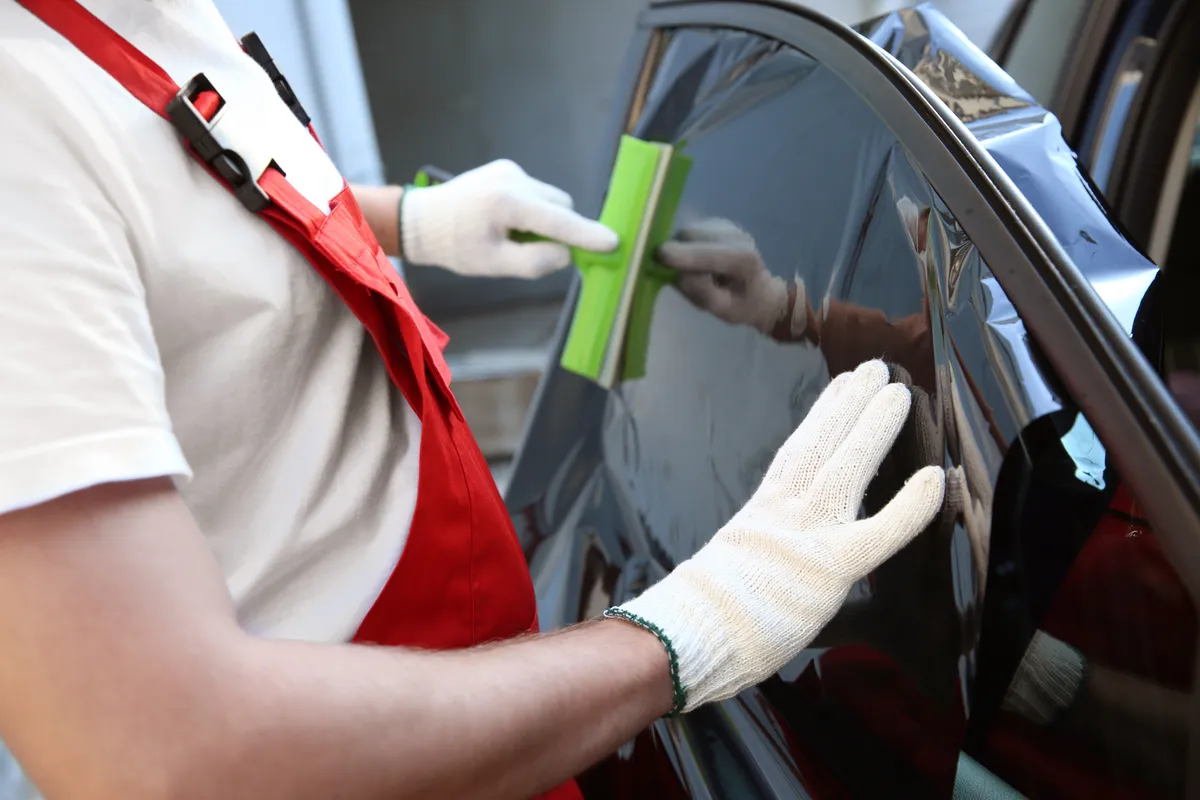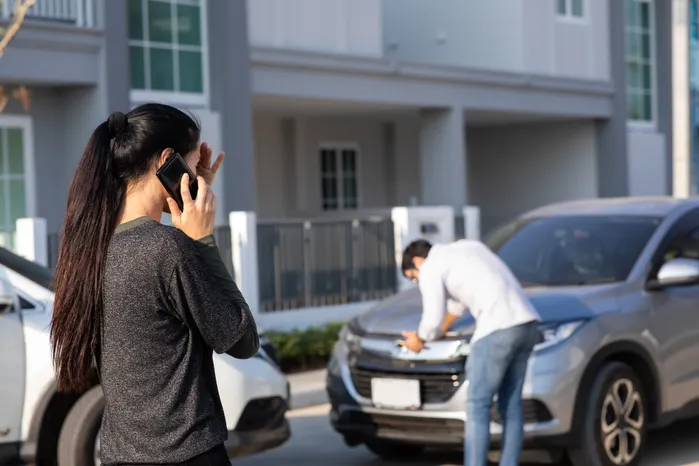5 min read time
Table of Contents
What Is Window Tinting
Window tinting is the process of applying a thin, transparent film to a vehicle's windows.
This film is made to reduce the amount of light, heat, and UV rays that pass through a vehicle's window.
Common reasons for window tinting are:
- Privacy
- Reduced glare
- Protection from harmful UV rays
Nevada Window Tint Laws
If you are considering getting window tinting in Nevada, it's essential that you first understand the state's laws regarding vehicle window tinting.
By knowing these laws, you can avoid potential complications such as fines, removing your tint, or needing a new window tint.
What Is the Darkest Tint Allowed in Nevada?

The Nevada window tinting laws are determined by the Visible Light Transmission (VLT) percentage or amount of light that can pass through the car windows.
According to Nevada Revised Statutes (NRS) 484D.440 , you can have a maximum window tint darkness of:
-
Front Windshield Tint Limit: Non-reflective tint is allowed along the top of the windshield; however, it must be above the vehicle manufacturer's AS-1 line.
-
Front Side Windows: The windows must allow more than 35% light through them.
Nevada Law for Window Tint Reflection
Window tint reflection substantially reduces glare and heat compared to non-reflective window tint. However, there are Nevada window tinting laws that regulate the reflectivity of tints.
According to NRS 484D.440:
-
Front Side Windows: Nevada's window tinting laws outline that these windows can not be more reflective than standard windows.
-
Rear Side Windows and Back Window: These car windows do not have a specific Nevada window tint law on reflectivity, but they must meet general safety standards.
Nevada Laws for Rear Window Tinting and Back-Side Window Tinting
Nevada has relaxed window tinting laws for back and rear window tinting.
The window tint rules for rear and back windows are:
-
Rear Side Windows: Nevada tinting laws don't set a VLT limit on rear side windows.
-
Back Window: Back windows don't have a VLT limit, either; however, vehicles with tinted rear windows must have dual side mirrors installed.
Can You Be Pulled Over for Window Tint in Nevada?
You can be pulled over in Nevada if law enforcement authorities suspect you of breaking the Nevada window tint rules outlined in NRS 484D.440.
Nevada Medical Exemptions for Window Tint
Nevada window tinting laws recognize some medical conditions that require tinted windows darker than the legal limits.
Nevada has medical exemptions for a car's window tinting to accommodate those needs.
Eligibility for Medical Exemptions
To obtain flexible window tinting laws in Nevada for medical conditions, the conditions must fall under the following:
-
Photosensitivity: Lupus , xeroderma pigmentosum, and other disorders that make you sensitive to light.
-
Skin Conditions: Severe skin conditions that require extreme UV protection.
-
Ocular Conditions: Certain eye conditions that make sunlight harmful.
To qualify for an exemption from Nevada's window tint laws, you must have a documented medical condition that requires darker window tints on the vehicle windows.
The Application Process for Medical Exemptions
Getting a medical exemption for window tinting in Nevada is relatively simple. Here are the steps:
-
Get Medical Documentation: Request a letter or statement from a licensed medical professional explaining your medical condition and why you need your windows tinted darker than the legal limit.
-
Fill out the Exemption Application: Fill out the medical exemption application form from the Nevada Department of Motor Vehicles (DMV).
-
Submit the Application: Submit the completed application form and medical documentation to the Nevada DMV. You can do this by mail or in person at a DMV office.
-
Wait for Approval : The DMV will review the application and medical documentation. If approved, you’ll receive a certificate or decal to display on your vehicle.
-
Display the Exemption: Always keep the exemption documentation in the vehicle, as this will prevent you from being stopped by law enforcement.
Do Nevada Tint Laws Apply to Out-of-State Vehicle Owners
Windows tint laws in Nevada don't apply to vehicles registered in other states; however, there are some considerations for out-of-state drivers:
-
Potential Traffic Stops: If your car's window tint is extremely dark or reflective, you may attract the attention of the Nevada Highway Patrol and be pulled over.
-
Temporary Compliance: When visiting Nevada, temporary adjustments to the window tint can be helpful to law enforcement and others.
Penalties for Illegal Window Tints
In Nevada, breaking window tint laws can result in fines, which vehicle owners need to know to know what to expect if they break the tint law.
How Much Is a Tint Ticket in Nevada?
Here are the penalties for illegal window tints:
-
1st Offense: The fine is usually $50 to $100 for a first-time offense. The exact amount depends on the jurisdiction and the circumstances of the violation.
-
2nd Offense: The fine for a second-time offense can be much higher. Additional offenses can be $100 to $200 or more.
-
Additional Fines: In some cases, the court can add additional penalties, such as requiring the vehicle owner to remove the illegal tint and have the vehicle inspected to ensure compliance. In addition, if the vehicle is in a car accident with illegal tint, that could be used against them in a car accident claim.
How to Measure a Window’s Tint
Tools to Measure Tint Darkness
Here are the tools to measure tint darkness:
Tint Meter: A handheld device designed to measure VLT percent through a digital readout of the light transmission.
Lux Meter: A lux meter can measure light through the window, but interpreting those readings to VLT will require further calculations.
Steps to Measuring Window Tint Darkness
-
Purchase a Tint Meter: Find a tint meter online or at auto parts stores.
-
Clean the Window: Ensure that the window is clean and obstruction-free. Dirt or residue will affect the reading.
-
Position Tint Meter: Place the tint meter over the window tint. Depending on the model, you may need to put the window into a slot in the meter or attach the meter to the window surface.
-
Take the Reading: Turn on the tint meter and take a reading.
-
Read the Results: Compare the output of the tint meter to the Nevada legal limits.
Tinting Tips for Nevada Drivers
If you are a Nevada driver and are looking to tint your windows, you should:
- Know the legal tint limits
- Use professional installation
- Opt for UV protection
- Check for reflective tints
By following these tips, you can have a more enjoyable tint process while abiding by Nevada's tint laws.
Talk to a Las Vegas Attorney Today
If you have been hurt in a car accident and seek maximum compensation, talk to an experienced Las Vegas car accident lawyer by calling (702) 566-3600.
Obtain the Compensation You're Entitled To
Contact Us Today
Rodney Okano Car Accident Lawyer is a Las Vegas personal injury law firm with over 20 years of experience helping clients obtain maximum compensation following injuries from accidents such as car crashes, worksite injuries, and slips and falls. Over those years, The Rodney Okano Car Accident Lawyer Law Firm has become an experienced law firm that can ensure exceptional results for any of its clients.



